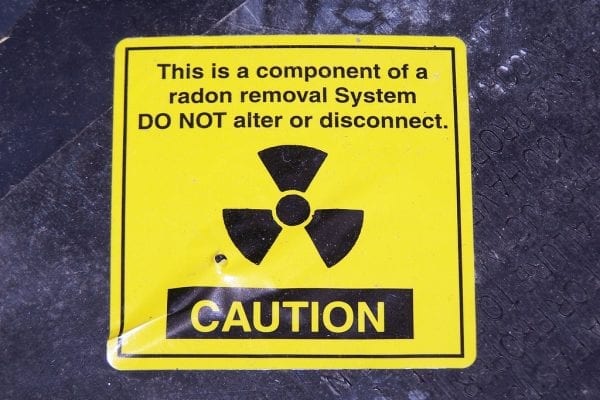Radon is the second leading cause of lung cancer, according to the National Cancer Institute, responsible for between 15,000 and 22,000 lung cancer deaths in the U.S. each year. Prolonged exposure leads to a 1 in 100 chance of contracting the disease. Here’s what you need to know to make sure that your child’s school is safe from radon.
What Is Radon and Why Is It a Problem?
Radon is a radioactive gas emitted by certain materials that are naturally present in some soils, including uranium, thorium, and radium.
Outdoors, this isn’t a problem, as the radon mixes with the atmosphere and is immediately diluted to safe levels. But when a building is constructed on top of radon-emitting soils, the gas can seep into the lower levels of the building and build up to harmful levels in the indoor environment.
Dangerous build-up of radon in buildings is especially common in areas rich in these radioactive materials, such as states along the Appalachian Mountains, some parts of New England, the Midwest, and areas along the Rocky Mountains. The Environmental Protection Agency has produced a county-level map (https://www.epa.gov/sites/production/files/2015-07/documents/zonemapcolor.pdf) of average radon concentrations throughout the US.
Radon can also become a problem in previously unaffected areas due to mining and other events and activities that disturb the composition of soils in the area. The central portion of Florida is an example of where natural occurring deposits of phosphate are common and contain other elements that can produce radon gas. Soils from these areas are often used as fill for new areas of development in Florida, which then leads to radon being released by the soils under these new developments.
For this and other reasons, it’s possible for radon to be a problem in buildings even in areas that are not generally prone to it, making it important to test for it regardless of the area’s history and geology.
What Should Schools Do to Ensure They’re Safe?
The EPA tightly regulates radon in schools, but that doesn’t mean that every school is in compliance with the EPA’s requirements.
According to the EPA’s “Radon in Schools” website, “A nationwide survey of radon levels in schools estimates that nearly one in five has at least one schoolroom with a short-term radon level above the level at which EPA recommends that schools take action.”
That comes out to an estimated 70,000 school rooms in active use that have high short-term radon levels. The EPA ranks indoor radon among the most serious environmental health problems facing schools and the rest of the country today.
State of Florida Testing Requirements
To address the problem, the State of Florida has established standards for testing and mitigating radon exposure in schools. Under the regulations, every school must test for radon within its first year of occupancy. It must be tested again at 5 years. If both tests come back below the EPA recommended level, then the requirement is fulfilled.
If radon levels above 4 picocuries per liter (pCi/L) are detected at any time, then further testing must be undertaken, with the recommendation to mitigate once confirmed and delineated.
Radon Mitigation Solutions
Often, radon mitigation can be accomplished using existing HVAC equipment within the building. An adequate inflow of fresh air from outdoors, which creates positive pressure to push indoor gases out of the building, can often be achieved using the HVAC system.
In some cases, schools that previously were safe from radon might experience a radon problem if the HVAC has been adjusted to save costs or for other reasons. In these cases, radon that previously was vented outdoors might build up indoors instead.
It’s important for schools to test periodically to ensure this doesn’t happen, and also to maintain awareness that changes to the HVAC system can cause changes to overall indoor air quality.
When mitigation is not possible with the use of existing HVAC equipment, excessive radon can be vented actively using a sub-slab depressurization system. This consists of a pipe under the slab that runs up through the building’s roof, with a fan to blow air out.
The fan creates a negative pressure inside the pipe, which causes it to draw gases out of the area below the building slab, and allows the venting of the radon gas safely into the environment, instead of letting it accumulate into the building itself.
How to Test a School for Radon
Radon exposure is generally easy to mitigate once you know it exists, but testing for it isn’t always consistently done and doesn’t always comply with the state for federal requirements.
At GLE, we’ve been testing for radon in schools and other buildings since the 1990s. We’re able to very quickly run tests on hundreds of rooms across dozens of schools with thousands of data points, and effectively identify problem areas and file State-compliant reports in a short period of time, with a high level of accuracy.
We start with school plans of the relevant schools and calculate the square footage and number of rooms to determine the correct number of sampling points. Some states require a certain percentage of rooms be tested, based on a number of factors. Most also require that rooms with entry points from subsurface areas, such as cabling and bathroom pipes, be prioritized for testing.
Radon levels are tested using activated charcoal, which adsorbs the radon gas and encapsulates it, making it possible for a lab to determine the radon concentration in the ambient air after 48 hours of exposure. We distribute packs of activated charcoal and open them in each room.
Each pack is associated with a barcode. At the time of placement, our technicians scan each barcode using a tablet and associate it in the system with the classroom number and the school. The system automatically records the date and time of placement.
After 48 hours, the packs are sealed and collected, and each one is scanned again. The system automatically records the time of pick-up. The packs are sent to the lab, which again scans each one before analyzing its contents.
Any problem areas are quickly identified and brought to the attention of the school’s administration. All test results are recorded in the system and used to automatically populate the required reports for our clients as well as the regulatory agencies, including digital signatures for both the testing firm and school administrators, which can amount to thousands of signatures per school district.
We care about the safety of children in schools, and we care about making the testing and mitigation as efficient and affordable as possible. Our radon experts are standing by to talk with you about your concerns or to schedule a radon assessment for your school system.





